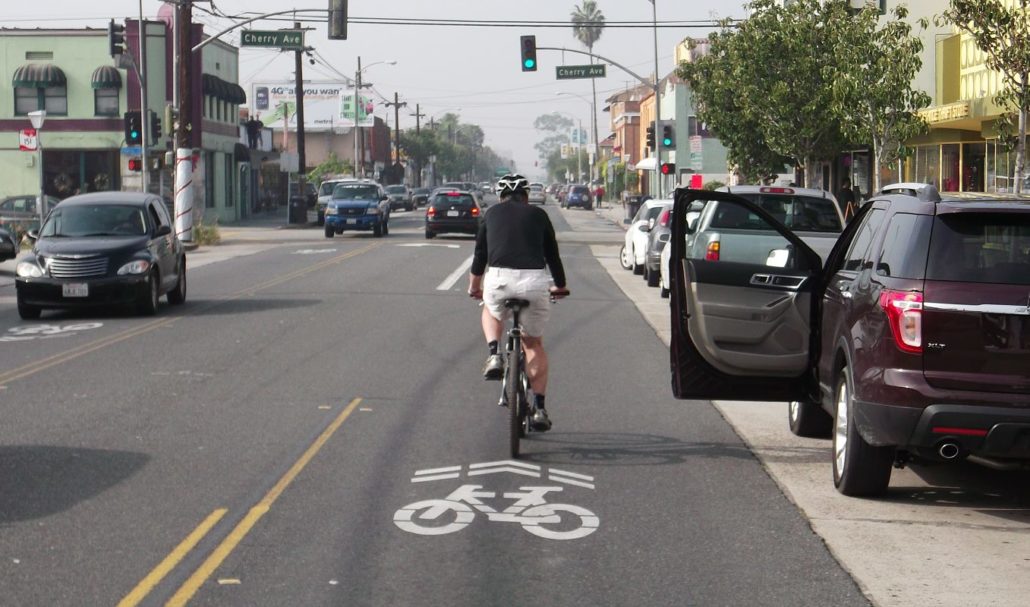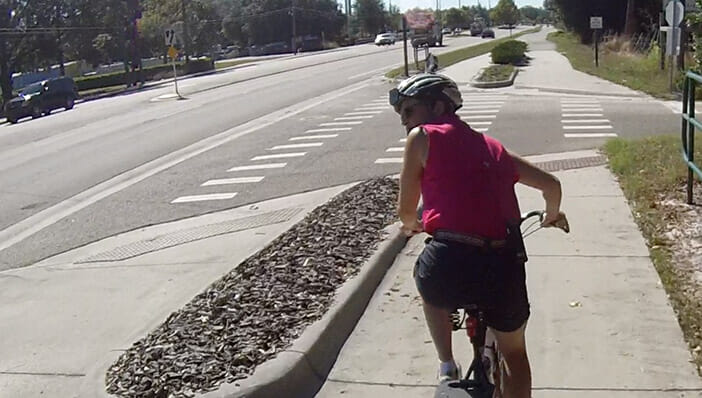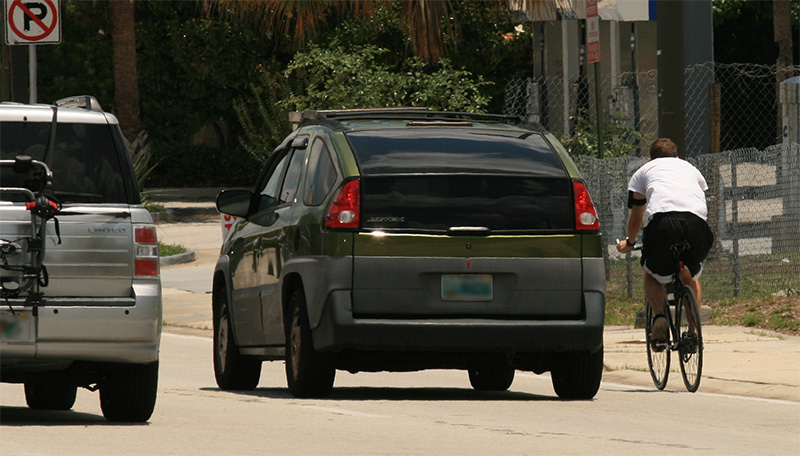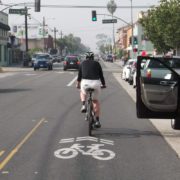Three Types of Bicyclist Behavior
In our “Beginner’s Guide” series, we are attempting to bring all facets of basic bicycle safety together::
- Equipment & Accessories: Is The Bike Safe to Ride?, plus lights, mirrors, bells, and other optional equipment and clothing.
- Skills: The Top 3 Bike Handling Skills, Braking and Cornering, Using Your Gears, and (coming soon) Emergency Maneuvers.
- Bicyclist Behavior: How what you know and what you do can keep you safe.
In this post, we start to discuss the third broad topic, bicyclist behavior.
We see a wide range of bicyclist behavior in the real world, and we can probably all agree that some of it is not so good. I don’t blame the cyclist, in most cases. Given the general lack of bicycling education in North America, many people grow up with little idea of how best to keep themselves safe while cycling with other traffic. We’re told as kids that the street is for cars and is dangerous. We usually get some basic-level training in how to use crosswalks.
But most cyclists do not get any formal cycling education beyond grade school, if even then. As teens and adults, they fall back on what their parents may have taught them when they were little, what they observe others doing, and what seems like “common sense.” So it’s understandable that many bicyclists adopt a “pedestrian on wheels” approach to getting around by bike. Like pedestrians, these cyclists try to stay out of the road as much as possible. These cyclists do not feel welcome on the road, they do not know what they are allowed to do or should do, and maybe don’t even think they belong there. They use sidewalks and crosswalks where available.

Bicyclist Behavior: Driver, Edge, Pedestrian.
CyclingSavvy identifies three categories of bicyclist behavior, as suggested by bicycling educator Dan Gutierrez. These are not intended to label the cyclist, just the behavior. The same rider may adopt any combination of these strategies during a single trip.
- Driver behavior: Use the road, following the normal driver rules, on the correct side and not always at the edge.
- Pedestrian behavior: Stick to pedestrian infrastructure wherever possible.
- Edge behavior: Ride on the road but stick to edge as much as possible (including riding against traffic).
Driver Behavior

The CyclingSavvy program builds on John Forester’s assertion that “cyclists fare best when they act and are treated as drivers of vehicles,” that is, driver behavior. But we recognize that driver behavior can be daunting at first. Not every bicyclist immediately has the knowledge and confidence to take it up. Also, becoming a pedestrian, and operating in pedestrian space, may be unavoidable or more convenient for parts of a trip.
Pedestrian Behavior

So, part of our instruction covers safe pedestrian behavior. This basically amounts to “go slow, and look carefully in all directions at driveways and intersections.” We also recommend dismounting in crosswalks, and on sidewalks if they are busy. Stay far away from doorways. If you are prepared to accept these limitations, and if sidewalk riding is legal where you are riding (check your state laws and municipal ordinances), then we won’t flat out tell you not to do it. But you have to go slowly to stay safe, and even beginners can go too fast sometimes. There may be too many pedestrians (the rightful users). And often, there isn’t a sidewalk anyway.
Edge Behavior

Of the three behavior types, edge behavior is probably the hardest to practice safely. While it generally allows for faster riding than pedestrian behavior, it renders the bicyclist less visible, less relevant, and less predictable than does driver behavior. It frequently leads to conflicts at intersections.
Despite all these limitations, it’s the default behavior for most beginning cyclists. Pretty much all of us began as edge cyclists, if not pedestrian cyclists. Remembering my early days, I had a limited understanding of bicyclist behavior options. I had a vague notion that I should obey all the same rules as car drivers, and not use the sidewalk. Yet, I did not yet have either the knowledge or the model for how to do anything beyond stay at the edge, even at intersections.
Does the Law Allow Driver Behavior by Bicyclists?
Like all traffic laws, laws about bicyclist behavior vary from state to state; check your state laws to be sure. But we can categorize them generally here, noting exceptions where we are aware of them.
Rights of a Driver
In all states and provinces in North America, bicyclists have generally the same rights and duties as other drivers. Some states define the bicycle as a vehicle, while others grant bicyclists the rights of drivers. The end result is the same, legally.
This is the starting point. Additional statutes may modify it.
As Far Right as Safe or Practicable?
Most, but not all, states have some kind of law stating that a bicyclist must ride as close as safe or practicable to the right curb or edge of the roadway, followed by a list of exceptions. “Practicable” — an unfamiliar word meaning that something is workable in practice. It is not the same as “far right as possible,” although impatient motorists and even some law enforcement officers may think of it that way.
It seems reasonable for drivers of slower vehicles to be considerate of drivers of faster vehicles. But what is really reasonable bicyclist behavior, and what is not? Ever since this law first appeared in the 1940s, exceptions (or, if you prefer, examples of impracticable situations) have been explicitly added, until in most states, the exceptions take many more words to define than the law itself! (In Maine, where I am, the basic law is 44 words, with 173 words, nearly 4 times as many, to describe the exceptions!) You could say that the exceptions outweigh the rule.

Exceptions Are the Rule
In most states, bicyclists are not required to keep to the right when :
- passing other slower traffic;
- preparing for or executing a left turn;
- proceeding straight in places where right turns are permitted;
- avoiding hazards at the edge (including but not limited to sand, debris, potholes, surface hazards, grates, glass, puddles, opening doors of parked cars);
- the lane is too narrow to share side by side within the lane.
The word “practicable”, correctly interpreted, encompasses these definitions, too. It comes down to this: You are never required to sacrifice your safety for someone else’s convenience! The “Bicycle May Use Full Lane” sign is a reminder of this. The sign does not have to be posted for this to apply.
We spend a great deal of time in CyclingSavvy on opening doors of parked cars, and how to handle narrow lane situations. For now, suffice it to say that we may legally use driver behavior, riding far enough away from parked cars to avoid not only the door itself, if it opens, but also to avoid being startled into swerving, which can be just as deadly. Indeed, whenever keeping to the right portion of the travel lane is not required, bicyclists have the right to use the full lane, that is, to ride anywhere they wish in the lane.
Bicyclist Behavior and Lane Widths
Here is the basic math:
- 4 feet: Bicyclist operating width, per U.S. Federal Highway Administration definition
- 3 feet: Minimum passing clearance
- 7 feet: Bare minimum width of a passing car; trucks can be 8 or 9 feet wide with the mirrors!
4 + 3 + 7 = 14 feet, the minimum lane width shareable with most cars and small SUVs. A standard lane is 12 feet wide, and some are narrower. The following diagram shows the minimum lane widths needed for safely sharing with motor vehicles of different types at different speeds.

A car is about 7 feet wide with its side mirrors. You can picture this total as wide enough to accommodate two small cars side by side, parked! Larger motor vehicles take even more room.
Required to Use Special Facilities?
Some states which have put a lot of effort into building bike lanes also have passed laws requiring bicyclists to use them. These laws tend to use the same kind of “practicable” language and exceptions as the Far Right as Practicable laws, so the decision is like whether to ride at the edge of a travel lane. Often, the same kind of hazards exist. Unfortunately, laws that presume to dictate bicyclist behavior can lead to both motorists and law enforcement not understanding good reasons for why a cyclist may not be using a bike lane.
We say, don’t let the paint think for you!!
Getting adequate passing distance is important in choosing lane position, but there are other considerations. More about this in a follow-up article.




